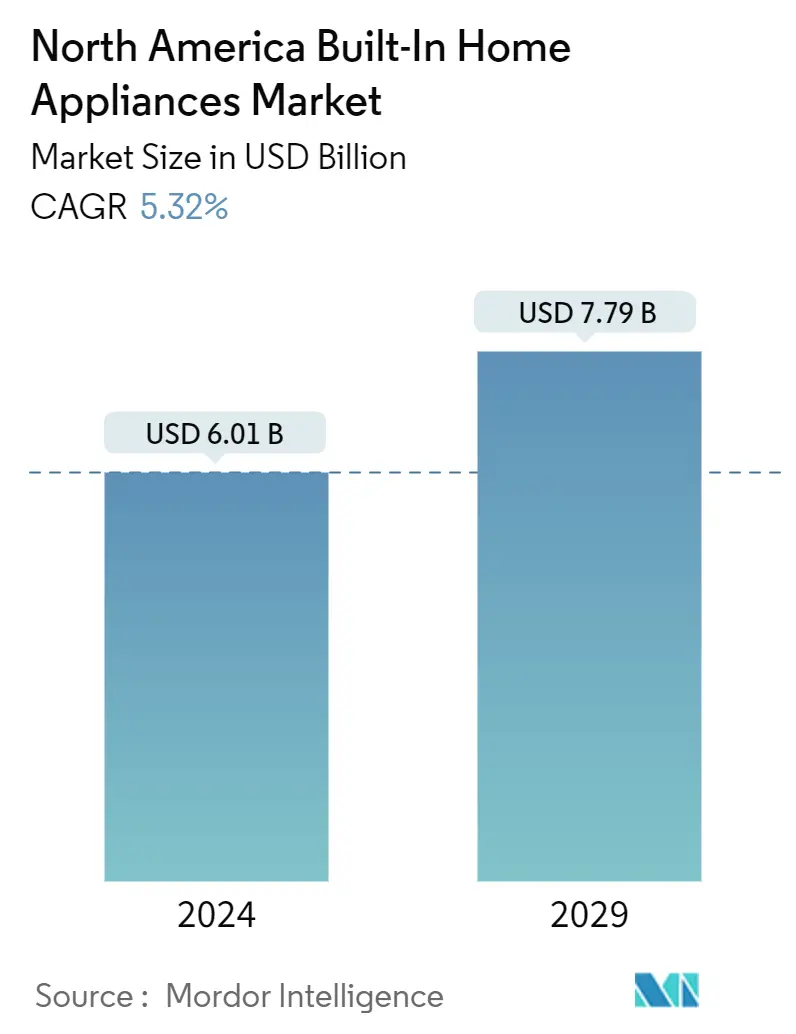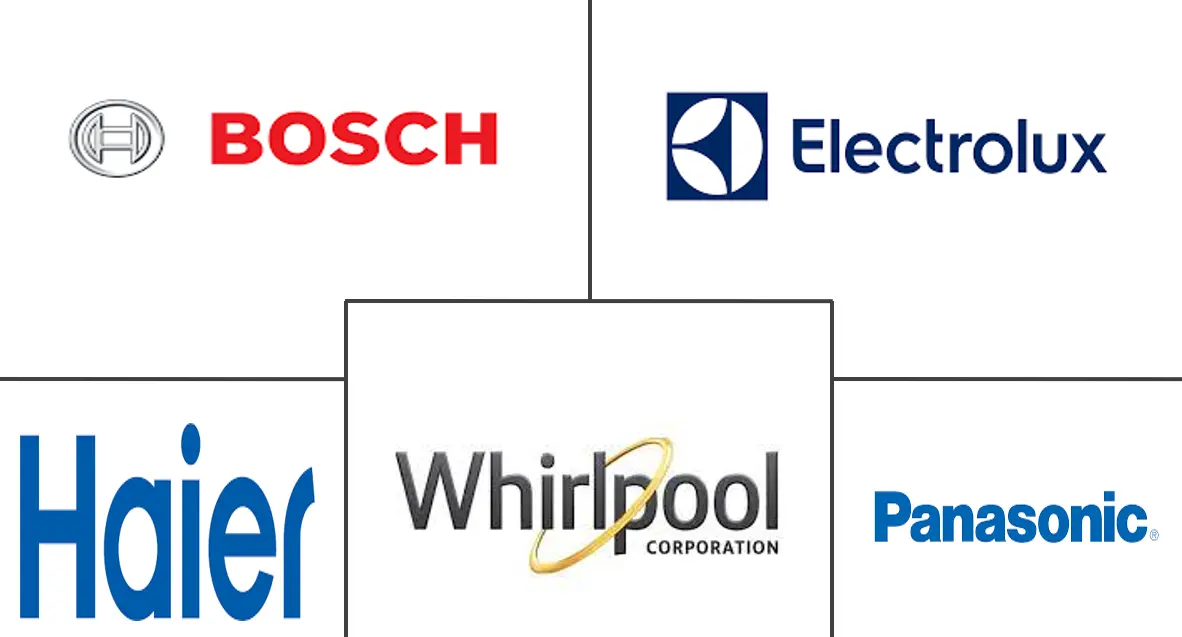Market Size of North America Built-In Home Appliances Industry

| Study Period | 2020 - 2029 |
| Base Year For Estimation | 2023 |
| Market Size (2024) | USD 6.01 Billion |
| Market Size (2029) | USD 7.79 Billion |
| CAGR (2024 - 2029) | 5.32 % |
| Market Concentration | Low |
Major Players
*Disclaimer: Major Players sorted in no particular order |
North America Built-In Home Appliances Market Analysis
The North America Built-In Home Appliances Market size is estimated at USD 6.01 billion in 2024, and is expected to reach USD 7.79 billion by 2029, growing at a CAGR of 5.32% during the forecast period (2024-2029).
The increased demand for built-in home appliances is due to the interest in home renovations, eco-friendliness, and smart home technologies. The rising demand for smart home devices contributes to the market's growth. Homeowners can use built-in home appliances remotely, increasing their convenience and efficiency. These technologically advanced built-in home appliances benefit the working population with busy work schedules.
The COVID-19 pandemic impacted the industry's sales due to the closure of workplaces and restrictions on supply chains and transportation. After the COVID-19 pandemic, the market's growth can be attributed to people working from home and the increased disposable income of consumers, which led to an increase in home furnishing and renovation. The market players conducted various R&D activities to improve product offerings.
The rising need for space utilization increases the demand for built-in home appliances. One of the advantages of built-in appliances is the facility to save space. The increasing trend of remodeling traditional homes to smart homes integrated with energy-efficient appliances drives the market. Consumers also invest more in home appliances due to the rising disposable income of emerging economies.
North America Built-In Home Appliances Industry Segmentation
Built-in home appliances are appliances installed in a cabinet. They are permanently installed, and built-in appliances are integrated into the home's layout so they can be customized to fit the available space.
The North American built-in home appliances market is segmented into product type, end-user, distribution channel, and geography. By product type, the market is segmented into built-in ovens and microwaves, built-in refrigerators, built-in hob, and built-in hoods. By end users, the market is segmented into commercial and residential. The market is segmented by distribution channel into supermarkets/hypermarkets, specialty stores, and e-commerce stores. The market is segmented by geography into the United States, Canada, and Mexico. The report offers market size and forecasts for the North American built-in home appliances market in value (USD) for all the above segments.
| By Product Type | |
| Built-in Ovens and Microwaves | |
| Built-in Refrigerators | |
| Built-in Hob | |
| Built-in Hoods |
| By Distribution Channel | |
| Supermarkets/Hypermarkets | |
| Specialty Stores | |
| E-commerce Stores |
| By Geography | |
| United States | |
| Canada |
| By End User | |
| Commercial | |
| Residential |
North America Built-In Home Appliances Market Size Summary
The North America built-in home appliances market is experiencing significant growth, driven by increasing consumer interest in home renovations, eco-friendliness, and the integration of smart home technologies. The demand for these appliances is bolstered by their ability to offer convenience and efficiency, particularly for homeowners with busy lifestyles. The market's expansion is further supported by the trend of remodeling traditional homes into smart homes equipped with energy-efficient appliances. The COVID-19 pandemic initially disrupted sales due to supply chain challenges, but subsequent shifts towards remote work and higher disposable incomes have spurred increased investment in home furnishings and renovations. This has led to a heightened demand for built-in appliances, which are favored for their space-saving benefits.
In the United States, the market is characterized by a strong preference for efficiency and intelligent technology, with consumers seeking appliances that are energy-efficient and controllable via smart devices. The proliferation of online shopping platforms, such as Amazon, has also contributed to market growth, offering consumers convenient purchasing options and attractive post-sale support. Social media plays a crucial role in influencing consumer decisions, with users relying on these platforms for product information and reviews. The market is fragmented, with major players like Robert Bosch GmbH, AB Electrolux, Haier Smart Home Co., Ltd., Whirlpool Corporation, and Panasonic Holdings Corporation actively engaging in strategic initiatives to maintain a competitive edge. Recent product innovations, such as Samsung's new oven with advanced monitoring features and LG's built-in kitchen package, highlight the ongoing advancements in this sector.
North America Built-In Home Appliances Market Market Size - Table of Contents
-
1. MARKET DYNAMICS AND INSIGHTS
-
1.1 Market Overview
-
1.2 Market Drivers
-
1.2.1 Increasing Household Disposable Income Drives the Market
-
1.2.2 Changing Lifestyles Drives the Market
-
-
1.3 Market Restraints
-
1.3.1 Repairing Challenges
-
1.3.2 Infrastructure and Space Limitations
-
-
1.4 Market Opportunities
-
1.4.1 Technological Advancements in Built-in Home Appliances
-
1.4.2 Durable and Energy Efficient
-
-
1.5 Industry Value Chain Analysis
-
1.6 Industry Attractiveness - Porters' Five Forces Analysis
-
1.6.1 Threat of New Entrants
-
1.6.2 Bargaining Power of Buyers
-
1.6.3 Bargaining Power of Suppliers
-
1.6.4 Threat of Substitutes
-
1.6.5 Intensity of Competitive Rivalry
-
-
1.7 Insights on Technological Innovation in the Market
-
1.7.1 The Integration of Internet of Things (IoT) Capabilities
-
-
1.8 Impact of COVID-19 on the Market
-
-
2. MARKET SEGMENTATION
-
2.1 By Product Type
-
2.1.1 Built-in Ovens and Microwaves
-
2.1.2 Built-in Refrigerators
-
2.1.3 Built-in Hob
-
2.1.4 Built-in Hoods
-
-
2.2 By Distribution Channel
-
2.2.1 Supermarkets/Hypermarkets
-
2.2.2 Specialty Stores
-
2.2.3 E-commerce Stores
-
-
2.3 By Geography
-
2.3.1 United States
-
2.3.2 Canada
-
-
2.4 By End User
-
2.4.1 Commercial
-
2.4.2 Residential
-
-
North America Built-In Home Appliances Market Market Size FAQs
How big is the North America Built-In Home Appliances Market?
The North America Built-In Home Appliances Market size is expected to reach USD 6.01 billion in 2024 and grow at a CAGR of 5.32% to reach USD 7.79 billion by 2029.
What is the current North America Built-In Home Appliances Market size?
In 2024, the North America Built-In Home Appliances Market size is expected to reach USD 6.01 billion.

